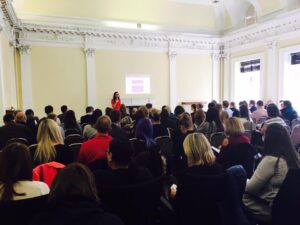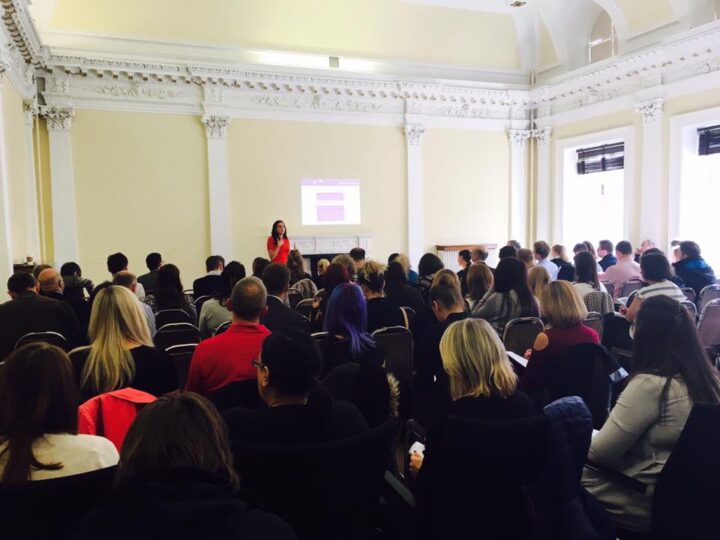Our content marketing masterclass, which we delivered as part of Leeds Business Week 2016’s customer conference on Tuesday, was attended by over 100 people, showing that there’s a real appetite for understanding more about the value of high quality content amongst Yorkshire businesses.

For those of you who didn’t make it – and those of you who did and have asked to see a copy of the slides to circulate around your teams, here’s a summary of what I covered in the session in the form of both my ramblings and the fantastic ‘sketch notes’ created by attendee Frances Noble (who is marketing assistant at Leeds University’s Business Confucius Institute) during the session!
First, some food for thought about customer outcomes:
The concept of content marketing isn’t new. Perry Marshall said in … well I don’t know what year but it was a long time ago! … that “nobody who bought a drill actually wanted a drill. They wanted a hole.” It’s an old adage but one that rings true in an age where consumers want to be educated about outcomes, not sold products.
Who says ‘content is king’?
It’s an over-used phrase that’s become a bit of cliché but content really is king (although, as I discussed in this blog back in 2015, many businesses are still treating it as the poor relation rather than royalty). But who says so? Google and Facebook say so – they’re constantly changing their algorithm to penalise salesy, keyword-stuffed marketing guff in favour of high quality, useful, relevant content (unless you pay to advertise with them of course even though they know this isn’t what their users want!) But ultimately, it’s YOU. That’s what people want to read, watch, share and engage with in the digital age. Not because digital platforms are any different to old school ones, just because the gatekeepers (journalists, editors etc) are no longer stopping us from accessing what we want.
Isn’t content marketing just an ‘add on’ service offered by digital agencies?
Nope. Well, yes it is but it shouldn’t be. Content marketing should be a multi-channel, integrated approach to customer, employee and stakeholder engagement tied into long term business goals. If it’s not, it won’t work. And it’s not just digital. One piece of really good content can be used across a whole range of different platforms from blogs to brochures.
Storytelling more than a ‘nice to have’
Organisations in 2016 need to be publishers if they are going to be able to reach and influence their target audiences over the long term. They should be investing in people with really strong writing and storytelling skills, not techies who can set up a ‘pay per click’ campaign or advertising/PR and recruitment agencies. That’s not to say that there isn’t a place for media relations, PPC or advertising in the future but it comes down to what will give the greatest return on investment, not just in terms of increased sales today and tomorrow but in terms of long term efficiency, profitability, reputation and growth.
Content comes first!
Before you write a press release, set up a Google ads campaign or build a website, you have to establish an authentic tone of voice and create high quality content that your target audiences want to read/watch/share. Otherwise your PR, advertising and digital efforts will go to waste – they might get you lots of ‘clicks’ but very little in terms of ‘conversion’. In 2016, it’s owned media, earned media, paid media – in that order!
It may be alien to old school sales people but creating content that is useful rather than salesy attracts buyers rather than just browsers. It will win you customers with a much greater life time value for much less effort and cost.
For a useful starting point, have a read of Jo’s recent blog on how to brief your developer on building your new website from a content point of view.

The 5 ‘e’s of content marketing
To illustrate the mindset change that is needed to embrace content marketing, we’ve come up with our 5 ‘e’s of content marketing which you can read about in more detail here. In brief, they are:
- Empathy – seek first to understand and then to be understood (using social media as a research tool is something I bang on about a lot including in this recent blog)
- Expertise – focus on your niche and don’t try to be ‘all things to all men’
- Education – add something of value to the readers’ life
- Excitement – you can tell engaging stories in even the most ‘boring’ of industries without trying to be something you’re not (read Chloe’s recent blog about how storytelling can transform your ‘boring’ business)
- Empowerment – give your staff, customers and stakeholders the tools and vehicles to be
Creating a content marketing strategy and plan
Here’s the hard bit: making it work. In order to do that your content marketing strategy needs to be over-arching and completely embedded across the organisation – a real challenge for marketers struggling to get heard at board level. Chloe’s recent blogs on why you should form a monogamous relationship with your content marketing strategy and her comparison between online dating and content marketing might help with this. Also have a read of my blog on what we can learn from Santa about content marketing.
When it comes to planning, you have to throw the traditional marketing plan out of the window! This doesn’t mean you can’t proactively plan for things but you also have to be reactive to your audiences’ ever changing agenda and flexible enough to respond quickly to topical things they’re talking about. Just make sure that you’re not creating content for the sake of – as I said in this recent blog, your content should be ‘all thriller, no filler’ to keep your audiences’ attention.
People focused content: why your employees make the best ‘models’
I talked quite a bit about people-focused content during the session, banging on as I usually do about the classic principle that ‘people buy people’. For a further discussion about this, have a read of this blog by my colleague Chloe about why your employees make the best ‘models’ drawing on her own experience of being roped into a photo shoot for one of our client’s campaigns, and this one I wrote about the use of stock images of 1980s people in headsets in the financial services sector.
This ties in to another favourite topic of mine – employer branding – which you can read more about in this blog on why strategic employer branding is the key to long term growth, not just another name for ‘recruitment marketing’.
User-generated content
Not monitoring, responding to and taking on board Trip Advisor/Trust Pilot/Glassdoor reviews by your customers and employees? Not searching social media platforms like Twitter and Instagram to find customer comments and images mentioning your brand name or products and thanking those customers and sharing their content? Not using client case studies and testimonials to tell stories about what you can offer to prospects? You’re missing a trick. Your biggest fans are your (free) sales force in the digital age – turn them into ambassadors and help them spread the word.
Staying ‘front of mind’
If you’re not being salesy, how can you get in front of target audiences when they’re bombarded with so much other content? Surely there’s no room for subtlety in 2016?! Just because we live in an information age doesn’t mean we only engage with what’s rammed down our throats. Consumers are very savvy and will seek out and ‘filter’ the stuff that’s most relevant, interesting and useful to them. If you’ve got a clear niche and you can find solutions to your audiences’ problems, you will be able to reach them. Social media gives you a whole world of insight into what they’re talking about, where and when. You can be part of the conversation without barging your way in.

Content marketing ROI
This all sounds great but how do you measure it and, most importantly, how do you persuade those who hold the purse strings to stop wasting money on other things that only deliver high volume outputs and not high quality outcomes and invest in strategic content marketing instead? It’s not easy because it requires a complete change in mindset and culture but it is possible and it will pay dividends.
Again, I could continue banging on about this for another 1700 words but instead, I’ll point you in the direction of this blog about the long term business benefits of content marketing. When it comes to measurement and evaluation, find out from Chloe why you don’t have to be a ‘geek’ to be on top of your analytics in this blog.
Another way to persuade others within your organisation why a change of approach is needed is to really challenge them on whether your current marketing efforts are a waste of time and money, which Jo covers in this blog.
Content marketing skillset
Lastly, I want to finish on a point that Jo makes in her latest blog about the skills that today’s marketing teams need from a ‘chief listening officer’ to ‘HR marketers’. If you’re currently letting a new graduate manage your social media channels because you think younger people are ‘better at it’ or your marketing team doesn’t have influence at board level, none of the above is going to work. We believe that content marketing seriously raises the bar in terms of business outcomes and that it should be recognised for that by organisations. In terms of return on investment, it’s actually cheaper and more impactful than most other forms of business development but you need to invest in the right people with the right skills to get that return.
If you’ve made it to the end of this mammoth blog (and maybe even clicked on a few of the links through to the other blogs I reference and had a read of them too) then well done! Still not got your fill? Or need something a tad more concise to share with your colleagues? Download a pdf of my presentation slides.



